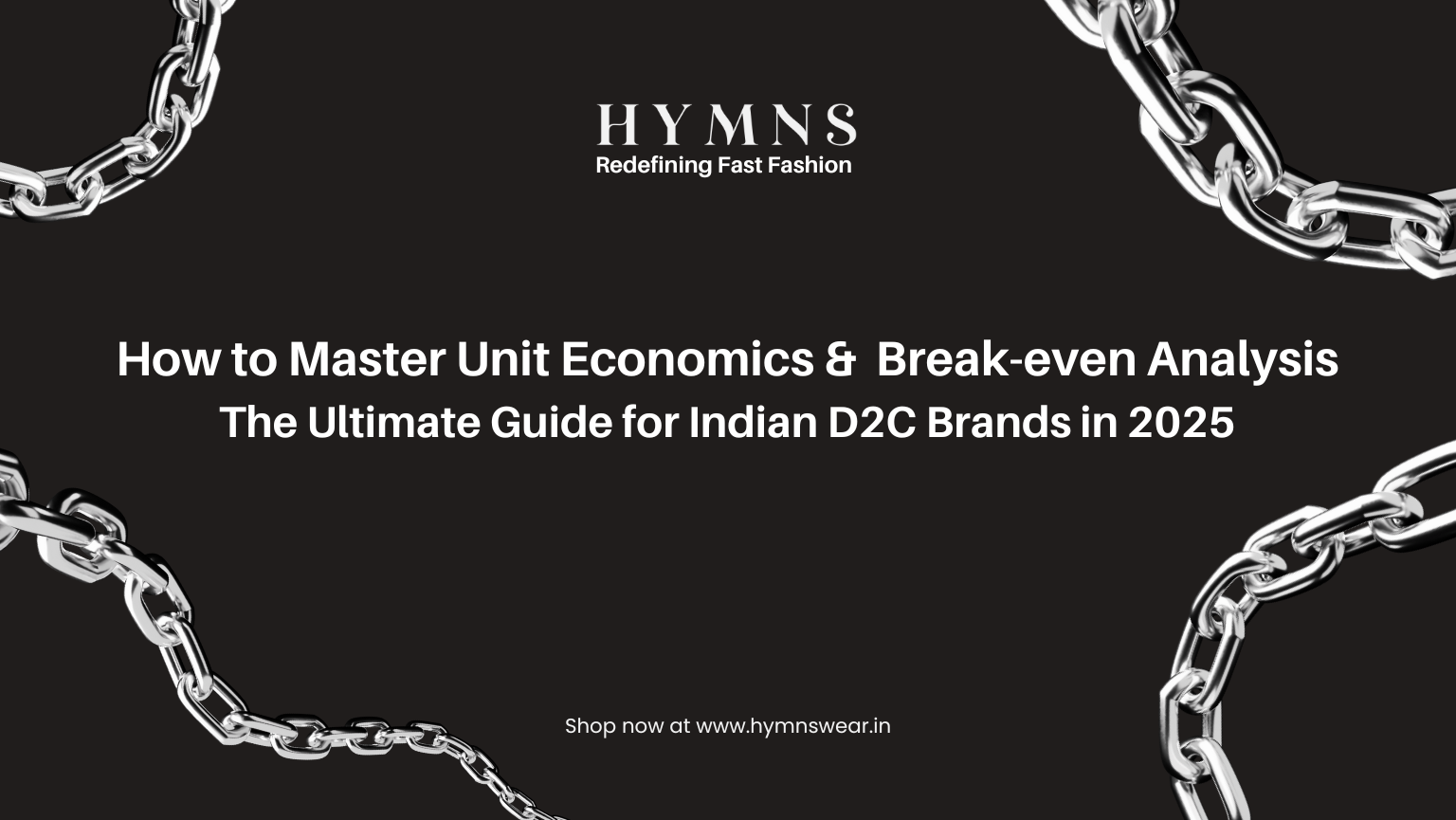In the rapidly evolving Indian e-commerce ecosystem, Direct-to-Consumer (D2C) brands are growing exponentially, but so are the challenges. Increasing competition, rising customer acquisition costs, unpredictable returns, and complex logistics are testing the profitability of even the most promising startups.
Understanding unit economics and break-even analysis is no longer optional — it is essential for survival and growth. This blog presents a complete, beginner-friendly guide to mastering these concepts, along with a powerful free tool developed by Hymns Wear, designed specifically for Indian D2C entrepreneurs.
What Is Unit Economics and Why It’s Critical for Your D2C Brand?
Unit economics measures the direct revenues and costs associated with a single sale of your product. It answers fundamental questions like:
- How much do I truly earn or lose on every product sold?
- Are my marketing spends justified against the revenue generated?
- How do operational costs such as packaging, shipping, and returns affect profitability?
In India’s context, where margins are often tight and costs vary widely by region and channel, unit economics offers a clear lens into whether your business model works or needs adjustment.
Break-even Analysis: Your Roadmap to Profitability
The break-even point tells you the minimum price or volume you need to sell to cover all your costs — fixed and variable.
Knowing this number helps you:
- Set realistic sales goals.
- Price products profitably without losing customers.
- Allocate marketing budgets with confidence.
- Plan inventory and cash flow effectively.
Introducing the Hymns Wear Unit Economics & Break-even Calculator
To empower Indian D2C entrepreneurs, we built an intuitive, robust calculator that incorporates all critical cost factors unique to India’s market:
- Manufacturing costs: Your purchase price per unit.
- Advertising spends: Meta (Facebook/Instagram), influencer marketing, Google Ads, affiliates.
- Packaging & shipping: Including courier variations across states.
- Warehousing costs: Storage and handling fees.
- Returns & cancellations: Percentage rates and cost impact.
- Payment gateway commissions: Different fee structures impacting net revenue.
- Discounts & loyalty rewards: Their effect on profit margins.
The calculator instantly shows:
- Profit per unit after all costs and discounts.
- Required ROAS (Return On Ad Spend) for ad channels.
- Suggested retail prices for various profit margin targets (from 10% up to 40%).
- Maximum discount you can offer without hurting profitability.
You can save multiple product profiles locally, compare scenarios, and download detailed reports for your team or investors.
Access the calculator here: https://hymns.store/advue/
Why Understanding Unit Economics Matters More Than Ever in India (2025 Edition)
Rising Customer Acquisition Costs (CAC)
With more brands advertising aggressively on platforms like Meta and Google, CAC has surged. Without clear unit economics, you risk spending more to acquire customers than you earn from them.
Logistics & Return Challenges
India’s diverse geography means shipping costs vary significantly. Returns and cancellations can eat into margins if not properly accounted for.
Price Sensitivity & Competition
Indian consumers are highly price-sensitive but expect quality and quick delivery. Balancing discounting with profitability requires precise calculations.
Payment Gateway & Taxation Complexity
Variations in payment gateway fees and GST impact your net revenue differently across products and regions.
Step-by-Step Guide: How to Use the Calculator Effectively
-
Gather Accurate Data: Collect your purchase price, ad spends per order, packaging/shipping costs, estimated return rates, cancellation rates, and payment gateway fees.
-
Input Data Into the Calculator: Enter these values in rupees (₹) into the calculator fields.
-
Analyze Outputs:
- Review profit per unit and profit margin percentages.
- Check required ROAS to set realistic ad campaign goals.
- Look at suggested retail prices for different profit targets.
- Understand maximum discounts allowed to maintain profitability.
-
Save Product Profiles: Store multiple products or scenarios for easy future reference.
-
Download Reports: Export CSV reports for deeper analysis or sharing with stakeholders.
Beyond D2C: Why Every Indian E-commerce Seller Should Know Unit Economics
If you are an online retailer, wholesaler, or marketplace seller in India, unit economics still applies. Knowing your real cost per sale helps optimize pricing strategies, improve marketing ROI, and manage inventory better — ultimately boosting profitability.
Frequently Asked Questions (FAQs)
Q1. What is a good profit margin for Indian D2C brands?
Typically, 20%-30% profit margins are healthy after accounting for all costs including marketing and logistics. Our calculator helps you set realistic targets based on your specific numbers.
Q2. How do returns affect profitability?
Returns increase handling costs and reduce net revenue. Even a 5% return rate can significantly reduce profits if not accounted for properly.
Q3. Can I use the calculator for products priced outside India?
Yes. While input is in INR (₹), you can convert your currency accordingly. The principles remain universal.
Q4. How often should I update my data in the calculator?
Regularly — especially after changes in supplier pricing, marketing spend, or logistics costs. This keeps your insights accurate.
Final Thoughts from Hymns Wear
Profitability is the backbone of sustainable growth. With rising costs and increasing competition in India’s booming e-commerce market, relying on gut feelings is risky.
Leverage data insights from our free Unit Economics & Break-even Calculator to make smarter decisions — optimize pricing, reduce losses on returns, allocate marketing budgets wisely, and grow your D2C brand confidently.
Visit https://hymns.store/advue/ now to start calculating your true business health today!









